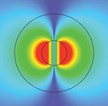The Smallest Laser Ever Made

Researchers have demonstrated the smallest laser ever, consisting of a nanoparticle just 44 nanometers across. The device is dubbed a "spaser" because it generates a form of radiation called surface plasmons. The technique allows light to be confined in very small spaces, and some physicists believe that spasers could form the basis of future optical computers just as transistors are the basis of today's electronics.
While the best consumer electronics operate at speeds of about 10 gigahertz, Mikhail Noginov, professor of physics in the Center for Materials Research at Norfolk State University in Norfolk, VA, notes that optical devices can operate at hundreds of terahertz. Optical devices are, however, difficult to miniaturize because photons can't be confined to areas much smaller than half their wavelength. But devices that interact with light in the form of surface plasmons can confine it within much tighter spots.
"There's currently a big effort, mostly theoretical, towards designing a new generation of nanoelectronics based on plasmonics," says Noginov. Unlike other previous plasmonic devices, spasers are an active element that can produce and amplify these waves. Noginov co-led the development of the new spaser with Ulrich Wiesner of Cornell University and Vladimir Shalaev and Evgenii Narimanov of Purdue University. The work is described today in the journal Nature.
The spaser made by Noginov and his collaborators consists of a single nanoparticle just 44 nanometers in diameter, with different parts that perform functions analogous to those in a conventional laser. In a normal laser, photons bounce between two mirrors through a gain medium that amplifies the light. The light in a spaser bounces around on the surface of a gold sphere in the nanoparticle's core in the form of plasmons.
The challenge, says Noginov, is to make sure that this energy does not dissipate rapidly from the metal surface. His team accomplished this by coating the gold with a layer of silica embedded with dye. This layer acts as a gain medium. Light from the spaser can remain confined as plasmons or it can be made to leave the particle surface as photons in the visible-light range. Like a laser, the spaser must be "pumped" to supply the necessary energy. Noginov's group accomplishes this by bombarding the particle with pulses of light.
SOURCE: Massachusetts Institute of Technology
